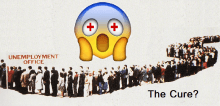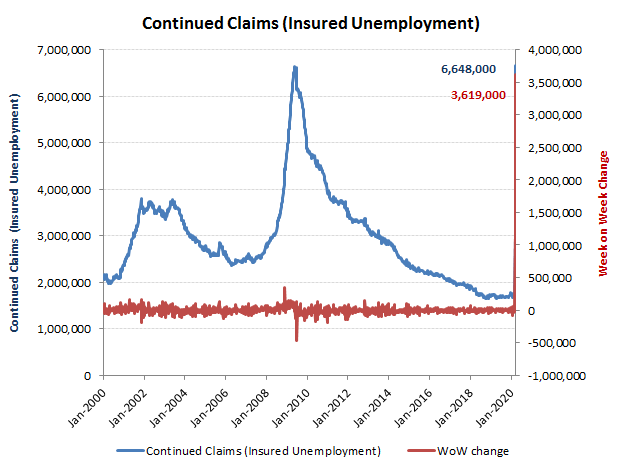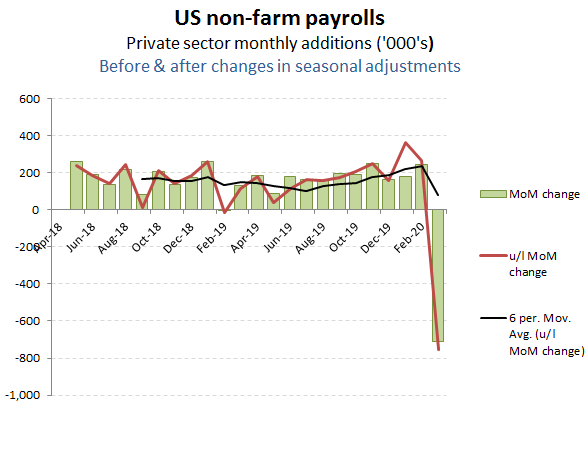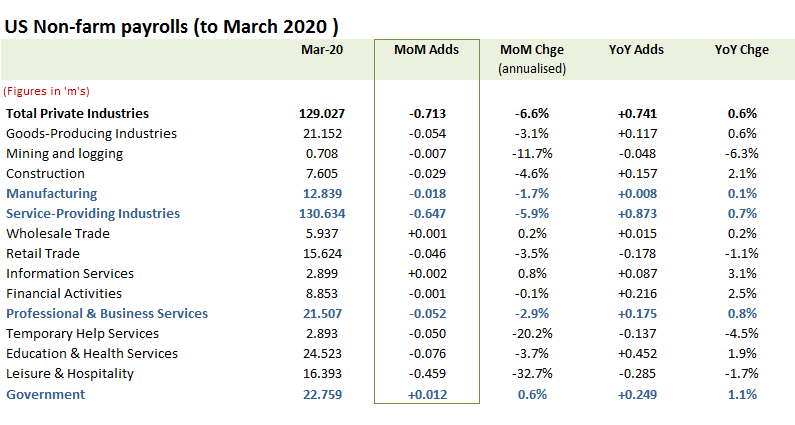When governments panic

The -713k contraction in US private sector employment in March was as dire as expected, but after the approx +6.4m increase in initial unemployment claims already reported in the two weeks up to the 28th March, this represents merely an hors d’oeuvre to what is coming down the pipe, With only limited effective testing (including for antibodies) and a vaccine possibly 6-9 months away, it remains unclear as to how much of the economy our governments are prepared to sacrifice until then. Get an economy like Zimbabwe and get the healthcare system that comes with it.
The March non-farm payroll data merely confirms the deep recession being faced across the West as the consumer sector contracts around ‘essentials and shutters a good 90% of airline capacity, most non-essential retailers, hospitality etc into Q2, with the full impact on GDP guestimated anywhere between a -15-30% (or more) contraction. As companies recover from the shock of finding themselves in a lockdown without any clear exit path, there has been a cascading reaction as businesses go into survival mode, slashing all discretionary investment, dividends acquisitions etc. With limited job protection, the US has one again exposed the brutality and speed of this process, with initial jobless claims rising from 282k in the week to 14th March to +3.307m to following week (to 21 March) and now to 6.648m for the week ending 28 March.

The guestimates that constitute the initial non-farm payroll numbers therefore need to be taken with an understanding that these are subject to subsequent revision, which following the harder unemployment claims data, may be quite substantial in this instance. The initial NFP estimates however, are useful directionally, albeit the revelation that jobs were cut in hospitality, retail and mining (fracking), perhaps ought to hardly come as a surprise.


When social isolation is needed to curtail infection, then you don’t need to be a genius to work out the sectors being initially exposed, albeit the current lockdown is perhaps acting as an accelerant to a preexisting structural shift, so perhaps one ought not expect too much of a bounceback once normality is restored. While those industries bringing people together for entertainment or trade are clearly the immediate casualities, the longer this persists, the more it will permeate into adjacent and connected industries. For policy makers this is a significant risk in that without a cllear path to normality, the current strategy might easily cascade from recession to depression, thereby undermining the economy’s capacity to rebound and leading to a considerably more protracted period of economic woes than the usual “over by Christmas” mantra would like us to believe. Governments are therefore playing with fire if they think they can muddle along in what increasingly clearly is a tactical response to an unexpected event rather than a coherent strategy on how to tackle it.

Schrodinger’s virus
Because we cannot get tested, we are unable to know whether we have the virus or not
We have to act as if we have the virus, so that we don’t spread it to others.
We also have to act as if weve never had the virus, because if we didn’t have it, we’re not immune.
Therefore, we both have and don’t have the virus.
Thus, Schrodinger’s Virus
